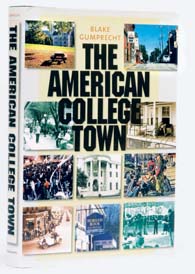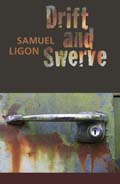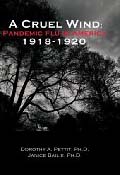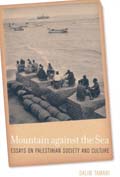|
Previews
Reviewed in this issue:
The American College Town
,
By Blake Gumprecht, associate professor and chair of the UNH geography department
Overviews:
Samuel Ligon '89G, Tilar Mazzeo '92 and Dorothy Pettit '67, '68G, '76G and Janice Bailie
In Their Own Words: William K. Millar, Jr. '68, David Cowdery '76, Andy Wilbur Remeis '86, Susan Lord '86 and Rod Story '59
Also of Note: Salim Tamari '67
News from Theatre and Dance alumni: Steve Freitas '07, Michael Graziadei '01, Maryann Plunkett '76, Basil Harris '94 and Libby Stevens '06
The American College Town
By Blake Gumprecht
University of Massachusetts Press, 2008
See at amazon.com

Blake Gumprecht has lived in or around college towns for most of his life. When he lived elsewhere, he writes, he longed for the mix of "sophistication and simplicity" that college towns offer, not to mention the "weird movies, adventurous bookstores, and contrary people" that often distinguish them. His second book, The American College Town (University of Massachusetts Press, 2008), is an exploration of the factors that characterize college towns, from the college campus itself--an American invention--to their status as bohemian islands. Gumprecht, an associate professor and chair of the UNH geography department, uses a humanistic and historical approach, and in places, his book reads like a memoir: it's a fascinating study.
The geography department is one of the smallest at UNH, but its scope of study is perhaps one of the broadest. "Geography is a very diverse discipline that is allied with the natural sciences, the social sciences and the humanities," Gumprecht says. "Any subject has a geographical element, so we're inveterate borrowers. Geographers are all over the place, pun intended." His research stems from his curiosity about what gives a place its personality, and his first book was about the Los Angeles River. Both of his books have won the J.B. Jackson Prize, the most prestigious award for cultural geographers who write about the United States. He is the first person to win the award twice.

It took Gumprecht 10 years to write The American College Town, and it is the first full-length study of its kind. He started with 60 study towns and compiled enough material to fill three file cabinets and a 6-foot-long book shelf. His eight chapters focus on traits that make college towns exceptional, and each includes a case study of one place; for example, his chapter on college towns as havens for iconoclasts focuses on Athens, Ga.
While Durham isn't one of Gumprecht's focus towns, readers will learn a lot about it. He finds it to be part of a peculiar variety of town specific to New England and akin to Orono, Me., Kingston, R.I., and Storrs, Conn., where the local population is smaller than the enrollment of the university. Gumprecht wonders why in these towns the growth of the university didn't stimulate residential and commercial development like it did in other towns. The best explanation, he says, comes from a University of Maine colleague who suggests that because the colleges were founded 250 years after European settlement, "the region's urban network was already fixed, which may have made it more difficult for emergent college towns to compete."
Gumprecht says his interest in college towns "stemmed from my perception that they aren't 'real' places. I needed to come to grips with that, having retreated to college towns many times in my life." Ultimately, he finds that their alternative "realness" is their virtue. "They are part of what makes life different in these United States," he writes. "They reflect the singular nature of American higher education and the indelible characteristics of American culture. They are distinctive, memorable, lively, and ever-changing." ~
Overviews:
|
Drift and Swerve
by Samuel Ligon '89G,
Autumn House Press, 2009.
See at amazon.com
In the 14 compelling short stories that comprise Ligon's second book, the characters steal, drive drunk, are violent and otherwise behave badly, but invite no judgment since he explores their foibles in unflinchingly honest but tender prose.
|

|
Back Lane Wineries of Sonoma
by Tilar Mazzeo '92,
The Little Bookroom, 2009.
See at amazon.com
This lovely little guidebook features photographs and descriptions of, and directions to, hard-to-find wineries that make limited amounts of handcrafted wines by on-site proprietors amidst stunning natural beauty.
|

|
A Cruel Wind: Pandemic Flu in America, 1918-1920
by Dorothy A. Pettit '67, '68G, '76G and Janice Bailie,
Timberlane Books, 2008.
See at amazon.com
Written by an historian and a biochemist, this highly readable social history of the "Spanish flu" draws on the medical literature, newspaper accounts, letters, diaries, memoirs and oral histories to show that the disease was more deadly and crippling than "all of the guns and gases" of World War I.
|

|
In Their Own Words:
Descriptions of new and recent written work by the authors themselves
William K. Millar, Jr. '68
See at lulu.com
Where is Crusader Rabbit Now That We Really Need Him?
When I graduated from UNH I was told by the ROTC department that, as a German major, I could expect to be sent to Germany as a Military Intelligence officer. Neither I, nor anyone who knew me, could picture me as an infantry officer, but there I was, all 115 pounds of me as a platoon leader in the First Cavalry Division. On the plane trip over to Vietnam, I started writing a journal. The opening paragraphs of my book are actually what I wrote on the plane that night. I maintained the journal until the monsoon rains rendered the paper un-writeable.
In 1974, I was newly divorced, teaching at York High School, in York, Maine, and still feeling the effects of Vietnam. I started writing down my experiences on the backs of unused test papers I pulled from the trash. It was finally completed in 1978. By this time, I was remarried to Susan Collins '71. She was teaching at UNH and represented the Nursing Department on the Faculty Senate. One of her fellow senators was Don Murray. She asked him if he would be interested in reading my book, and so, he took the manuscript, still on the old tests and bound up in four term paper folders. About a week later, he called and asked me to come over to his office some afternoon when I was done teaching. Needless to say, I went with some trepidation.
After trading war stories, Don handed the manuscript to me and asked me what I was planning to do with it. I said I didn't know, and would probably just stash it somewhere. In typical Don Murray fashion, he graphically told me why I should try to publish it. I won't use his exact words, but they were from one infantryman to another. Last year, my eldest daughter decided she would take the manuscript to Lulu.com and make a book for me as a Christmas present, and so here it is. It is available on Lulu.com as well as Amazon.com.
|
 |
|
David Cowdery '76
See at outskirtspress.com
The Misadventures of Sister Mary Olga Fortitude
Hello, fellow alumni! I have just had my first novel published under my pen name, Davis Aujourd'hui. The first in a series of nine novels, my book is irreverent and bawdy with a spiritual message for people from all walks of life. Sister Mary Olga is a bourbon-swilling, chain-smoking nun who takes pot shots at the conservative religious, political, and social attitudes of the day. She is a great believer of "to each one's own." Among the cast of diverse characters is: the Reverend Mother, who is a reformed prostitute; the convent's chef, who is a gay cowboy; and the nasty town prude and busybody, Priscilla Bunhead who is always digging in the dirt, and there's plenty of that for her to find in the fictional town of Bucksnort, Wisconsin. The scenarios are outrageous and the humor is over the top! I consider my series of books to be a cross between The Tales of the City series by Armistead Maupin, and Garrison Keillor's books. It is available for purchase on Amazon, and please write a review if you buy it. My web page is: http://www.outskirtspress.com/misadventuresofsistermaryolgafortitude.You can read a sample chapter there, and listen to an audio excerpt.
I developed my characters to entertain a colleague of mine during the twenty years that I worked for New York State Adult Protective Services, and two years ago, I decided to write a book about them. Over the course of two years, I wrote nine novels in the series and I still haven't run out of ideas! I am a recovering alcoholic and I am gay, as are several of my characters -- I speak from my own experience. The second book in the series, Babes in Bucksnort, should be published sometime this year.
|

 |
|
Andy Wilbur Remeis '86
See at dinnerco-ops.com
Dinner At Your Door: Tips and Recipes for Starting a Neighborhood Cooking Co-op
One of my clearest food memories is of discovering lobster while I was a student at UNH. I quickly expanded my eating repertoire during my UNH years, sampling a world of untried cuisine in Portsmouth. After graduation, I moved to Breckenridge, Colorado. I worked in banking and moonlighted in many restaurants while also getting in some great ski days. In 1995, after marrying, my spouse and I moved to Boise, Idaho where we still live. Early on I took classes at BSU in the Culinary Arts Program with the intention of opening my own catering business. In 1998, my daughter was born. I quickly rethought the commitment of working nights and weekends and settled down to enjoy a busy family life with many projects on the side.
Dinner At Your Door is my second child. Instead of 9 months of "pregnancy," this second gestation lasted over four years, and was born in the fall of 2008. It is about starting and sustaining a dinner co-op, and about a lifestyle that includes interdependence, enjoying your time and valuing the food that is put on your table. It is about how to sit down with your family and eat healthy, balanced meals, all week long.
I have been part of a dinner co-op since 2001. In my co-op, I cook once a week, on Tuesdays, for my family and two other families. I deliver dinners, hot and ready to eat, on my bike and then I head home and have dinner with my own family. On Mondays and Thursdays, every week, it is Culinary Christmas. The gifts are fresh, home-made meals delivered to us. I have not shopped for the food, cooked or washed pots and pans. Instead, I have been given that extra time to do what I want, whether it is helping with homework, working on a project or playing outside. There are many other ways a dinner co-op has changed my life. I feel less hurried at dinnertime. I have a meal plan. With this plan, I spend less money on better food. I feel like I am leaving a smaller footprint on the earth as I have cut down my grocery trips and take out containers. I love the fact that on my dinner co-op nights there is only one oven on cooking dinner for twelve.
Our book will show you how to work this magic. My co-authors and I show you how to find your circle of chefs and how to make it fit your life. We provide all the logistical information for any variable based on our combined commitment to co-ops of over 20 years. With this experience, we have found the "recipe" for what makes a dinner co-op successful. We also include many forms to use with co-op partners to get you on the same page and keep it fun to continue. Although we provide all of the how-to's, our book is also a cookbook full of tantalizing recipes. The 65 plus recipes, with beautiful photographs, are specially developed for co-op cooking. These dishes offer the perfect starting point for meals that can be made ahead of time, that travel well, and that won't dry out after drop-off. These are recipes that work. I hope you find a way to make them work for you. If you are interested in more information, check out our website: www.dinnerco-ops.com
Bon Appétit!
|

 |
|
Susan Lord '86
See at amazon.com
Getting Your Kid on a Gluten Free Casein Free Diet
When my oldest daughter was developing as an infant, I had a sense that she was not a "typical" child. She was unusually shy; she would hide under tables around new people. She would spin wheels on toy trucks compulsively, wasn't interested in dolls, and didn't play with age-appropriate toys in a meaningful way. She was very quiet, didn't coo or babble, and she seldom smiled or laughed. I went on the quest that every parent goes on when they suspect their child is different.
We started seeing Dr. Mary Megson, a pediatric developmental specialist in Richmond, Virginia, when Jenny was 5 years old. Dr. Megson diagnosed her with "Pervasive Developmental Disorder" (PDD) which falls on the "autistic spectrum" and suggested that we try Jenny on a diet free of wheat and milk products (a gluten-free casein-free diet) as part of her therapy. While I am a registered dietitian and had been for 11 years at that time, I was freaked out and intimidated, but we did it anyway. There was not a lot of information on the diet nine years ago and I thought, "Geez, if I am having a hard time with this, how do moms that don't have a degree in human nutrition feel?" It was then that I realized that the Universe had just plopped my life's purpose in my lap. I accepted the challenge and started writing a book on how parents could get their child on a gluten-free casein-free diet.
I saw the effects of the new diet quickly. After about three weeks on the diet, Jenny started to improve socially, her speech improved, she started drawing people in detail, she stopped spinning things, she stopped lining things up, and generally dropped all of her autistic symptoms. Today, she no longer carries the PDD diagnosis, and no longer falls on the autistic spectrum; however, she is "cognitively impaired" and is enrolled in a special education program at school. My book for includes daily meal plans, handy shopping lists, and over 70 recipes. It was published in February of this year, nine years after I started writing it.
Jenny has been on the gluten-free casein-free diet for about nine years, and I truly believe that she has progressed so wonderfully because of the major changes in her diet. Yes, indeed, it is hard to carry out day after day, and yes, the school parties are a challenge, as well as the pancake suppers, the spaghetti dinners and just eating out in this fast paced, "I want it now" America that we live in. From screaming at my husband, "I need a bigger kitchen!" to accidentally using two cups of salt instead of two cups of sugar in a "decadent" (not very!) chocolate cake recipe, our gluten free, dairy free journey has added a whole new dimension to our family life. It has challenged us, but we have met it head on with a robust sense of humor and a new appreciation for accepting ourselves just the way we are.
Through my child's special needs and restrictive diet, I have learned so much about life, love and myself. When it comes to my kid and the progress she is making, I am learning to accept less than perfect from her, from me, and from my spaghetti.
|

 |
|
Rod Story '59
See at amazon.com
School Leaders Needed
My book tells of my career as a teacher and high school principal in New Hampshire and Connecticut. The Connecticut River has been a constant in my family's life. Coming from Claremont, NH, my career as a teacher started in Middletown, CT, with five years in Madison, on Long Island Sound. We moved back to Newport, NH, near the Sugar River (which flows into the Connecticut River), then to Lebanon, NH. Later, we returned to Middletown while I was a principal at Coginchaug High School (the Coginchaug River flows into the Connecticut in Middletown), then Hale-Ray High School in East Haddam, and finally at Cromwell, which is right on the river.
My book is a challenge to our best classroom teachers to accept the role of building leader, to recruit and support more dedicated people like themselves, to promote the ideal of excellence for all students. Our public schools, the foundation of our future, need the best teachers as leaders.
I have so many memories from twenty-six years as a principal, but one explains why I am still sentimental about my career. In 2000, my wife Joy was diagnosed with stage two breast cancer. She spent until the next May undergoing intensive chemotherapy. During that time, the teaching staff left me notes every day for months, telling me to pick up all the fixings for a dinner for two in the faculty room. Often, Joy could not dine with me, but the habit of my microwaving the dinner, then seeing what Joy might be able to attempt, then my cleaning up the dishes to return the next morning, kept us from dwelling on the hurdles we faced. The spirit of that faculty helped keep up our spirits, and Joy has now been a survivor for nine years. We remain very active in Relay for Life, and our four daughters support the cause in Connecticut and New Hampshire.
|
 |
Also of Note...
Mountain against the Sea: Essays on Palestinian Society and Culture
by Salim Tamari '67,
University of California Press, 2009.
See at amazon.com
Drawing on previously unavailable biographies of Palestinians, Tamari's book is a series of vignettes of Palestine's cultural life in the first half of the twentieth century. Tamari is Professor of Sociology at Birzeit University in Palestine, and Director of the Institute of Jerusalem Studies, as well as editor of its journal, The Jerusalem Quarterly.
|
 |
News from alumni of the Department of Theatre and Dance:
- Steve Freitas '07 can be seen in a television commercial for W.B. Mason airing on the NESN and YES networks. Steve is also "Paul the Gorilla" in season one of the remake of "The Electric Company" which airs on Fridays on PBS.
- Michael Graziadei '01 recently appeared in the new ABC series "Castle." He also has a new movie out on DVD, "Into the Blue 2, The Reef."
- Tony winning actress Maryann Plunkett '76 has signed on to play Chris Cooper's wife in "The Company Men," a recession-inspired drama that was shot in the Boston area this spring. The movie also stars Ben Affleck, Kevin Costner and Tommy Lee Jones.
- "My Effortless Brilliance," an independent film starring Basil Harris '94, who co-wrote it, was recently released through Amazon-on-Demand. The film is about an urban author who travels to the backwoods of Washington to repair a broken friendship.
- Libby Stevens '06 is currently working in the Broadway revival of "West Side Story" as a child guardian, part of the stage management team.
|
Anne Downey '95G, a freelance writer who lives in Eliot, Maine, received her Ph.D. in English from UNH.
|























